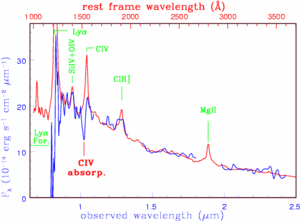NICS-TNG DISCOVERS an EXTREMELY POWERFUL EXPANDING WIND in the MOST DISTANT QUASAR KNOWN
Due to the cosmological redshift many of the most interesting features of the most distant quasars are shifted into the near-IR band, a spectral region where the reduced sensitivity of past instrumentation prevented a detailed study of many of their spectral features. The Near Infrared Spectrograph (NICS) operating at the TNG has been equipped with a low dispersion-high throughput element (an Amici prism) which enables to study the broad spectral features typical of quasars with unprecedented sensitivity.
The blue line in the figure above shows the near-IR spectrum of the most distant quasar known, SDSS J104433.04-012502.2, at z=5.80, obtained at the TNG during the commissioning of NICS. The red line is a template obtained by the combination of a sample of quasars at z~1. The most intersting result is the blueshifted absorption feature of the CIV. This feature classifies this object as a Broad Absorption Line quasar. The blueshifted CIV absorption is ascribed to gas outflowing with velocities in excess of 10000 km/s.
This finding, combined with the recent observation of this quasar in the X-rays with the XMM-Newton satellite (astro-ph/0010328),
suggests that the outflowing gas obscures the quasar in the X-rays with a column of gas
larger than Nh > 1024 cm-2, i.e. a brick-wall made of a huge amount of gas. The
implied outflow of mass ejected into the intergalactic medium is larger than 5 solar
masses per year!
For more details see the paper recently accepted on Astronomy & Astrophysics (astro-ph/0104147).


